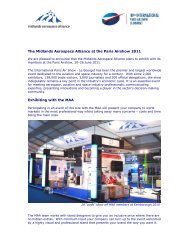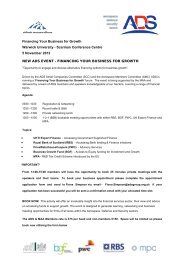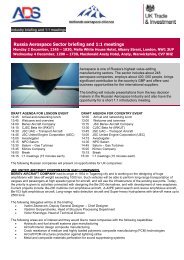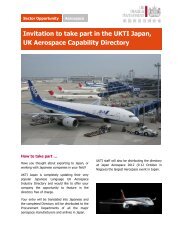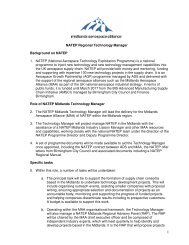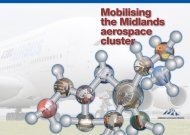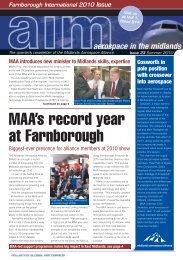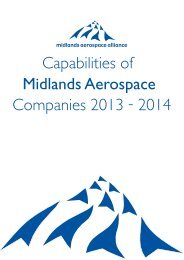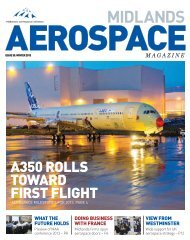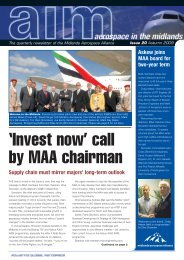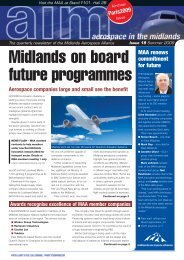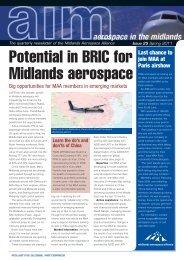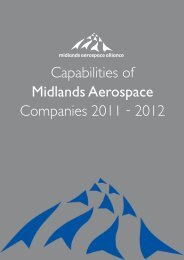Aerospace
Midlands Aerospace Alliance
Midlands Aerospace Alliance
Create successful ePaper yourself
Turn your PDF publications into a flip-book with our unique Google optimized e-Paper software.
PROFILE<br />
View from the boardroom<br />
The right service offering<br />
is the key element<br />
MAA board member Simon Beech, divisional managing director of Nasmyth<br />
Group and managing director of Bulwell Precision Engineers, shares his<br />
thoughts on the industry and its challenges.<br />
Q. WHERE DID YOU START YOUR CAREER?<br />
A. I started with Lucas Industries as a<br />
graduate trainee, straight out of university.<br />
In common with most large companies,<br />
they moved me around so I got a grounding<br />
in automotive and aerospace. I started in<br />
HR and worked my way through into sales<br />
and marketing, business development and<br />
project management. After 17 years with<br />
Lucas, and at the point where its ownership<br />
was changing, I was head-hunted by<br />
Leonard Sedgwick, the founder and owner<br />
of Bulwell Precision Engineers. It was<br />
still a privately owned family business and<br />
Leonard was 80, so about three years<br />
after I joined, in 2003, we sold the<br />
business. Bulwell became the initial<br />
acquisition of the Nasmyth Group,<br />
and remains the largest. I sit on the<br />
Nasmyth board and take a lead role in our<br />
machining, surface treatment and OEM<br />
manufacturing business.<br />
Q. COULD SOMEONE STARTING OUT<br />
TODAY TAKE THE SAME PATH?<br />
A. Yes, I think so. Working in a large plc is<br />
a good grounding for anybody. You learn<br />
all the management tools and techniques<br />
and gain experience across the breadth<br />
of those organisations. Lots of people get<br />
trained in large businesses, then go to<br />
smaller ones where they can apply their<br />
experience. You probably couldn’t go the<br />
other direction, small to large, because the<br />
skill and knowledge base is different.<br />
Q. WHAT HAVE YOU LEARNED IN<br />
INDUSTRY THAT YOU COULDN’T LEARN<br />
IN UNIVERSITY?<br />
A. The mechanics of work and business.<br />
It tends to be about relationships,<br />
managing and interacting with people.<br />
You can’t learn that through a degree<br />
programme or anything else.<br />
Q. WHO HAS INFLUENCED OR INSPIRED<br />
YOU IN YOUR CAREER?<br />
A. I had a couple of mentors who<br />
encouraged me to explore more general<br />
business options; people in senior HR<br />
functions who’d made the transition<br />
themselves. They supported me to do<br />
my MBA to gain the knowledge needed<br />
in that sort of role. I’ve done the same,<br />
helping develop people from the shop<br />
floor to populate management roles in<br />
our business. It’s good to see people<br />
developing, and it’s good for the business.<br />
“Working in a large plc is a<br />
good grounding. You learn<br />
management techniques and<br />
gain experience across the<br />
breadth of the organisation.”<br />
Q. WHAT DO YOU SEE AS THE BIGGEST<br />
THREAT TO THE AEROSPACE INDUSTRY?<br />
A. That depends on the level. From<br />
the supply chain view, it’s ignoring<br />
globalisation. There aren’t as many prime<br />
customers in Europe as there were. You<br />
have to look beyond, to those you’re not<br />
familiar with. Globalisation is affecting<br />
what we do and how we respond to it<br />
is crucial. I see it as both a threat and<br />
opportunity. If you have the right skills and<br />
strategy in your business to go and explore,<br />
it’s an opportunity. If you don’t, it’s a threat.<br />
Q. IS THERE A SECRET TO GAINING<br />
COMPETITIVE ADVANTAGE?<br />
A. Having the right service offering is<br />
the key element. If you can make your<br />
customer’s cost of acquisition better,<br />
your UK-made goods will be affordable.<br />
Exporting is a big part of our business.<br />
Export volumes change; overall it is<br />
close to 20%, however when you look<br />
where our products ultimately go on<br />
an aircraft or engine, and after our<br />
customer exports their product, our export<br />
percentage is closer to 70% of output.<br />
That’s got to be good.<br />
www.bulwell.com<br />
14 MIDLANDS AEROSPACE



